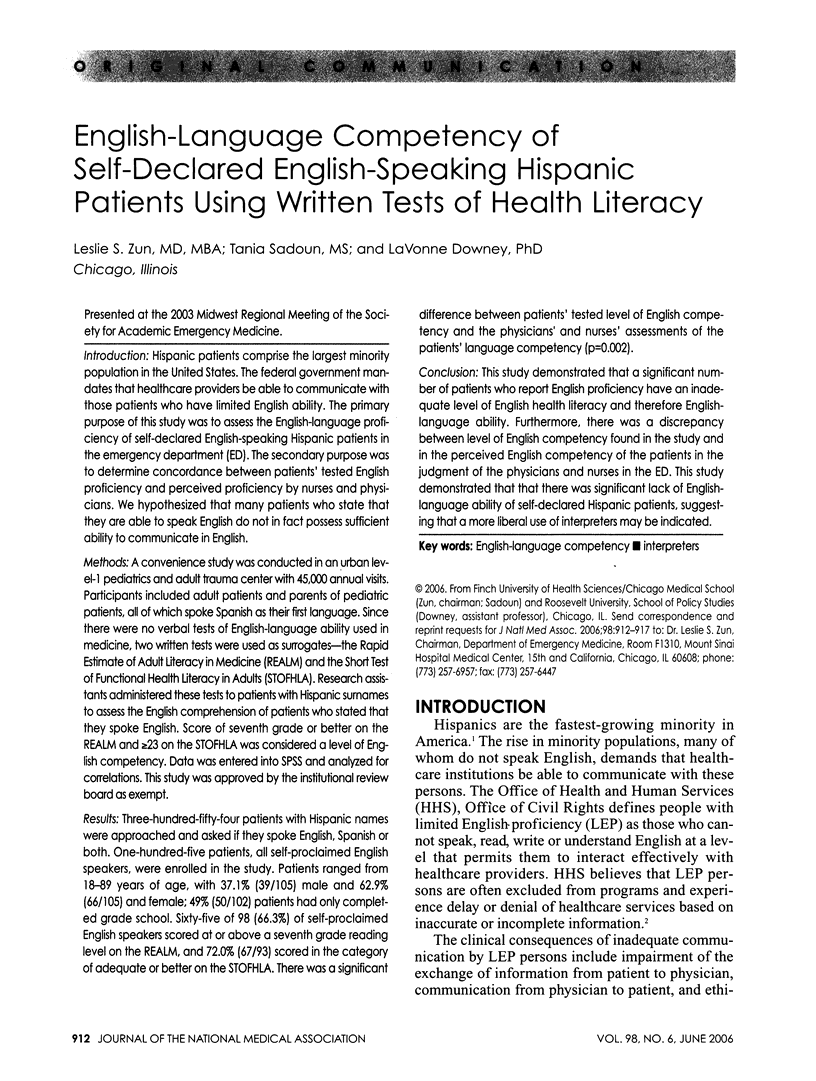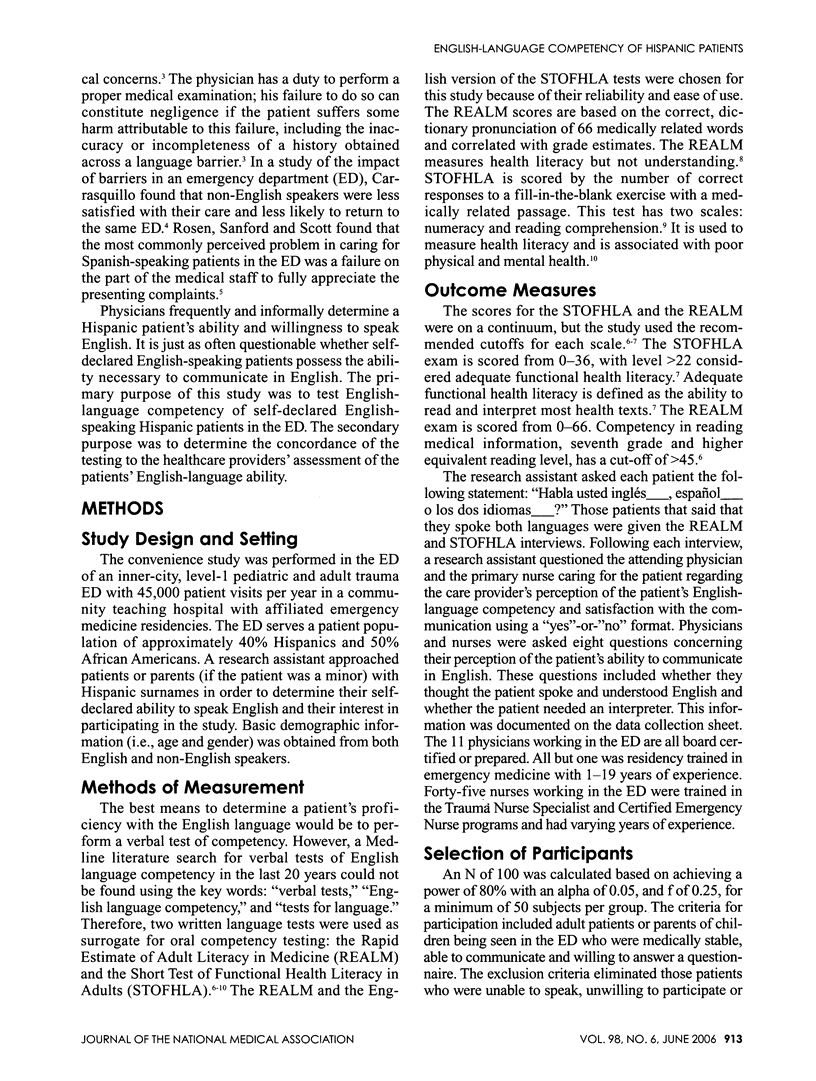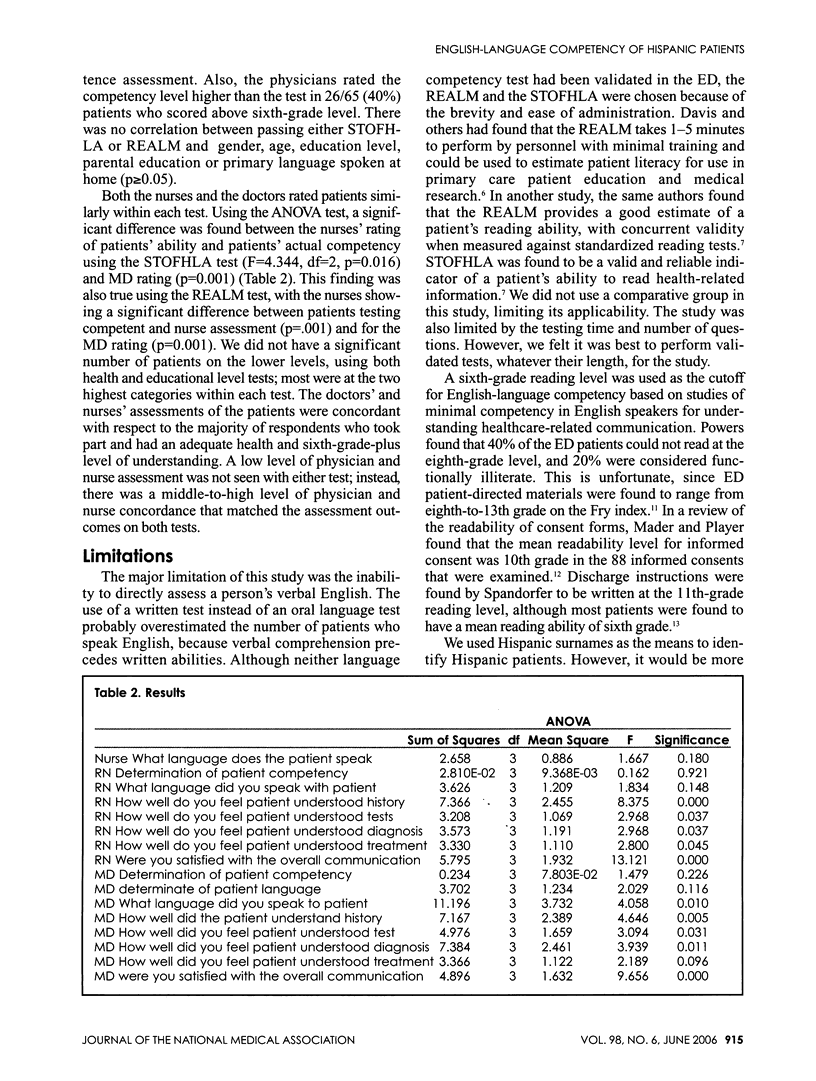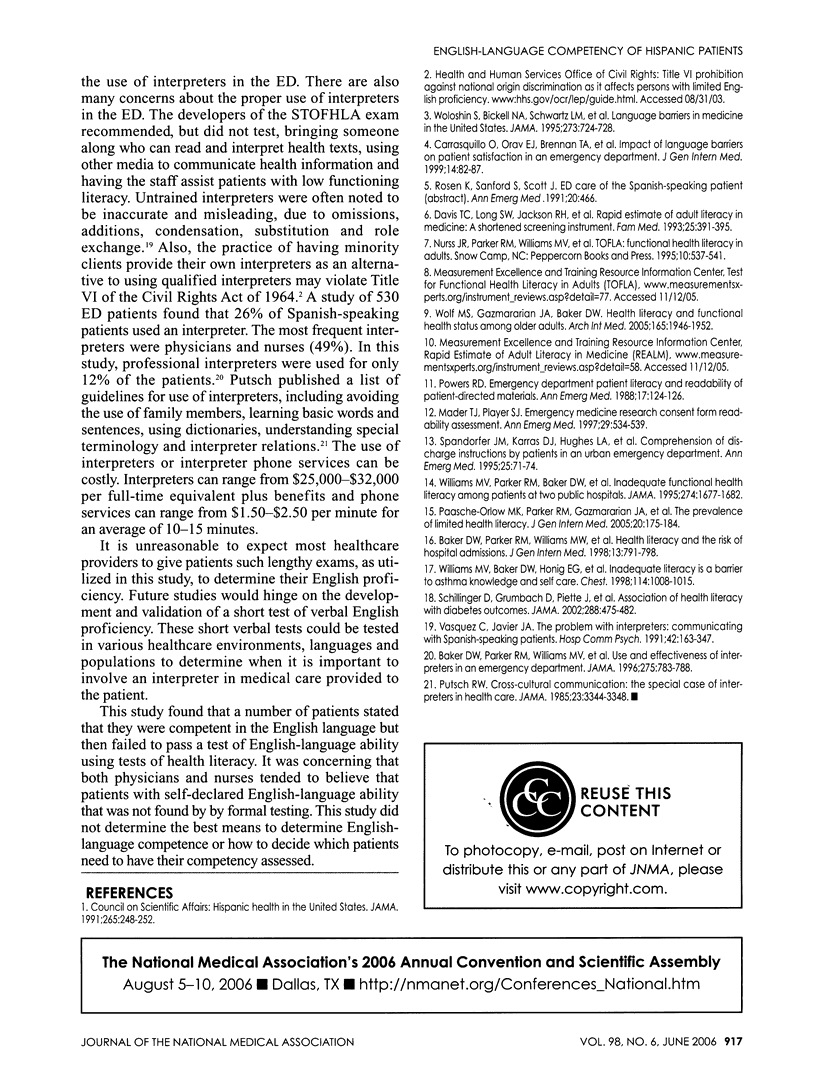Abstract
INTRODUCTION: Hispanic patients comprise the largest minority population in the United States. The federal government mandates that healthcare providers be able to communicate with those patients who have limited English ability. The primary purpose of this study was to assess the English-language proficiency of self-declared English-speaking Hispanic patients in the emergency department (ED). The secondary purpose was to determine concordance between patients' tested English proficiency and perceived proficiency by nurses and physicians. We hypothesized that many patients who state that they are able to speak English do not in fact possess sufficient ability to communicate in English. METHODS: A convenience study was conducted in an urban level-1 pediatrics and adult trauma center with 45,000 annual visits. Participants included adult patients and parents of pediatric patients, all of which spoke Spanish as their first language. Since there were no verbal tests of English-language ability used in medicine, two written tests were used as surrogates-the Rapid Estimate of Adult Literacy in Medicine (REALM) and the Short Test of Functional Health Literacy in Adults (STOFHLA). Research assistants administered these tests to patients with Hispanic surnames to assess the English comprehension of patients who stated that they spoke English. Score of seventh grade or better on the REALM and > or = 23 on the STOFHLA was considered a level of English competency. Data was entered into SPSS and analyzed for correlations. This study was approved by the institutional review board as exempt. RESULTS: Three-hundred-fifty-four patients with Hispanic names were approached and asked if they spoke English, Spanish or both. One-hundred-five patients, all self-proclaimed English speakers, were enrolled in the study. Patients ranged from 18-89 years of age, with 37.1% (39/105) male and 62.9% (66/105) and female; 49% (50/102) patients had only completed grade school. Sixty-five of 98 (66.3%) of self-proclaimed English speakers scored at or above a seventh grade reading level on the REALM, and 72.0% (67/93) scored in the category of adequate or better on the STOFHLA. There was a significant difference between patients' tested level of English competency and the physicians' and nurses' assessments of the patients' language competency (p=0.002). CONCLUSION: This study demonstrated that a significant number of patients who report English proficiency have an inadequate level of English health literacy and therefore English-language ability. Furthermore, there was a discrepancy between level of English competency found in the study and in the perceived English competency of the patients in the judgment of the physicians and nurses in the ED. This study demonstrated that that there was significant lack of English-language ability of self-declared Hispanic patients, suggesting that a more liberal use of interpreters may be indicated.
Full text
PDF





Selected References
These references are in PubMed. This may not be the complete list of references from this article.
- Baker D. W., Parker R. M., Williams M. V., Clark W. S. Health literacy and the risk of hospital admission. J Gen Intern Med. 1998 Dec;13(12):791–798. doi: 10.1046/j.1525-1497.1998.00242.x. [DOI] [PMC free article] [PubMed] [Google Scholar]
- Baker D. W., Parker R. M., Williams M. V., Coates W. C., Pitkin K. Use and effectiveness of interpreters in an emergency department. JAMA. 1996 Mar 13;275(10):783–788. [PubMed] [Google Scholar]
- Carrasquillo O., Orav E. J., Brennan T. A., Burstin H. R. Impact of language barriers on patient satisfaction in an emergency department. J Gen Intern Med. 1999 Feb;14(2):82–87. doi: 10.1046/j.1525-1497.1999.00293.x. [DOI] [PubMed] [Google Scholar]
- Davis T. C., Long S. W., Jackson R. H., Mayeaux E. J., George R. B., Murphy P. W., Crouch M. A. Rapid estimate of adult literacy in medicine: a shortened screening instrument. Fam Med. 1993 Jun;25(6):391–395. [PubMed] [Google Scholar]
- Mader T. J., Playe S. J. Emergency medicine research consent form readability assessment. Ann Emerg Med. 1997 Apr;29(4):534–539. doi: 10.1016/s0196-0644(97)70229-4. [DOI] [PubMed] [Google Scholar]
- Paasche-Orlow Michael K., Parker Ruth M., Gazmararian Julie A., Nielsen-Bohlman Lynn T., Rudd Rima R. The prevalence of limited health literacy. J Gen Intern Med. 2005 Feb;20(2):175–184. doi: 10.1111/j.1525-1497.2005.40245.x. [DOI] [PMC free article] [PubMed] [Google Scholar]
- Parker R. M., Baker D. W., Williams M. V., Nurss J. R. The test of functional health literacy in adults: a new instrument for measuring patients' literacy skills. J Gen Intern Med. 1995 Oct;10(10):537–541. doi: 10.1007/BF02640361. [DOI] [PubMed] [Google Scholar]
- Powers R. D. Emergency department patient literacy and the readability of patient-directed materials. Ann Emerg Med. 1988 Feb;17(2):124–126. doi: 10.1016/s0196-0644(88)80295-6. [DOI] [PubMed] [Google Scholar]
- Putsch R. W., 3rd Cross-cultural communication. The special case of interpreters in health care. JAMA. 1985 Dec 20;254(23):3344–3348. doi: 10.1001/jama.254.23.3344. [DOI] [PubMed] [Google Scholar]
- Schillinger Dean, Grumbach Kevin, Piette John, Wang Frances, Osmond Dennis, Daher Carolyn, Palacios Jorge, Sullivan Gabriela Diaz, Bindman Andrew B. Association of health literacy with diabetes outcomes. JAMA. 2002 Jul 24;288(4):475–482. doi: 10.1001/jama.288.4.475. [DOI] [PubMed] [Google Scholar]
- Spandorfer J. M., Karras D. J., Hughes L. A., Caputo C. Comprehension of discharge instructions by patients in an urban emergency department. Ann Emerg Med. 1995 Jan;25(1):71–74. doi: 10.1016/s0196-0644(95)70358-6. [DOI] [PubMed] [Google Scholar]
- Vasquez C., Javier R. A. The problem with interpreters: communicating with Spanish-speaking patients. Hosp Community Psychiatry. 1991 Feb;42(2):163–165. doi: 10.1176/ps.42.2.163. [DOI] [PubMed] [Google Scholar]
- Williams M. V., Baker D. W., Honig E. G., Lee T. M., Nowlan A. Inadequate literacy is a barrier to asthma knowledge and self-care. Chest. 1998 Oct;114(4):1008–1015. doi: 10.1378/chest.114.4.1008. [DOI] [PubMed] [Google Scholar]
- Williams M. V., Parker R. M., Baker D. W., Parikh N. S., Pitkin K., Coates W. C., Nurss J. R. Inadequate functional health literacy among patients at two public hospitals. JAMA. 1995 Dec 6;274(21):1677–1682. [PubMed] [Google Scholar]
- Wolf Michael S., Gazmararian Julie A., Baker David W. Health literacy and functional health status among older adults. Arch Intern Med. 2005 Sep 26;165(17):1946–1952. doi: 10.1001/archinte.165.17.1946. [DOI] [PubMed] [Google Scholar]
- Woloshin S., Bickell N. A., Schwartz L. M., Gany F., Welch H. G. Language barriers in medicine in the United States. JAMA. 1995 Mar 1;273(9):724–728. [PubMed] [Google Scholar]


